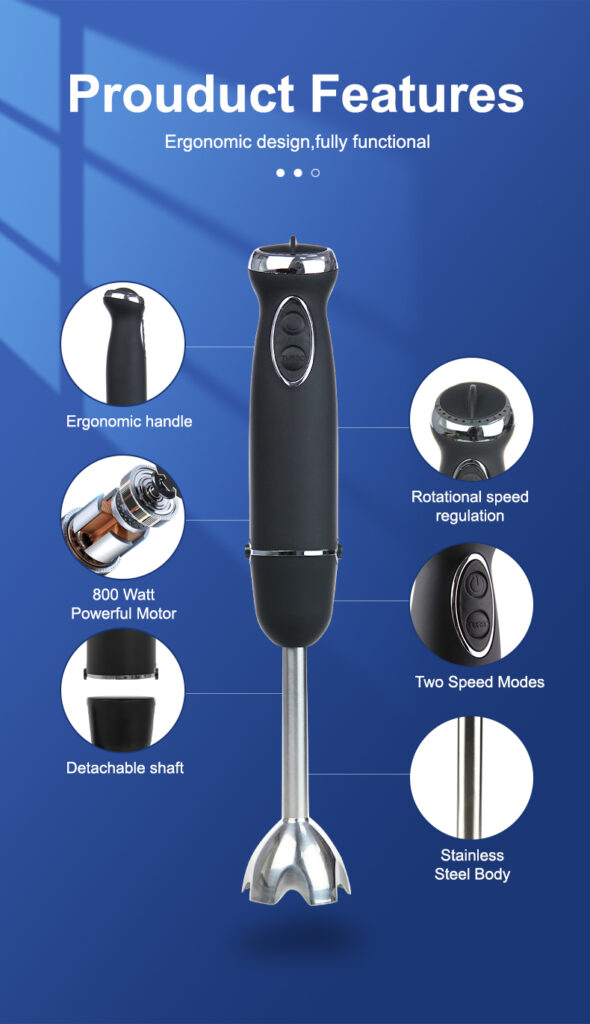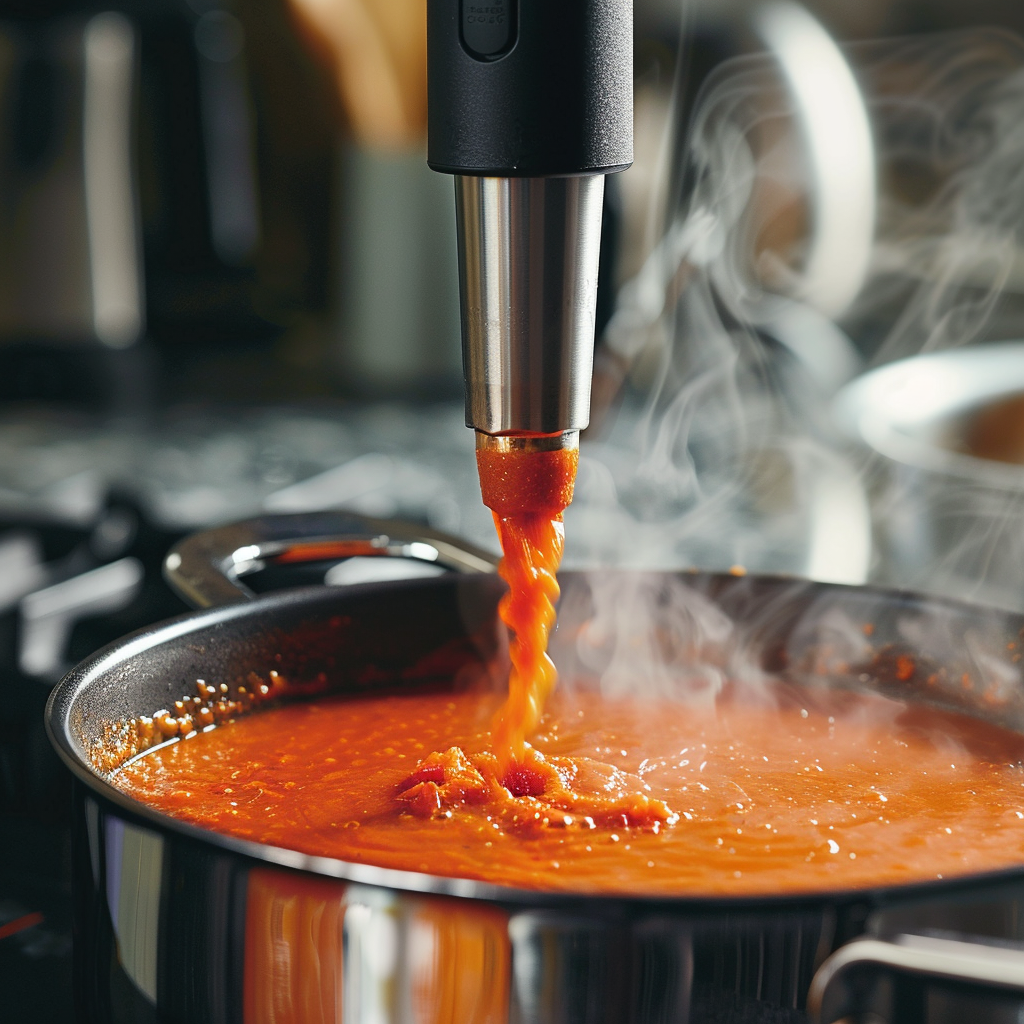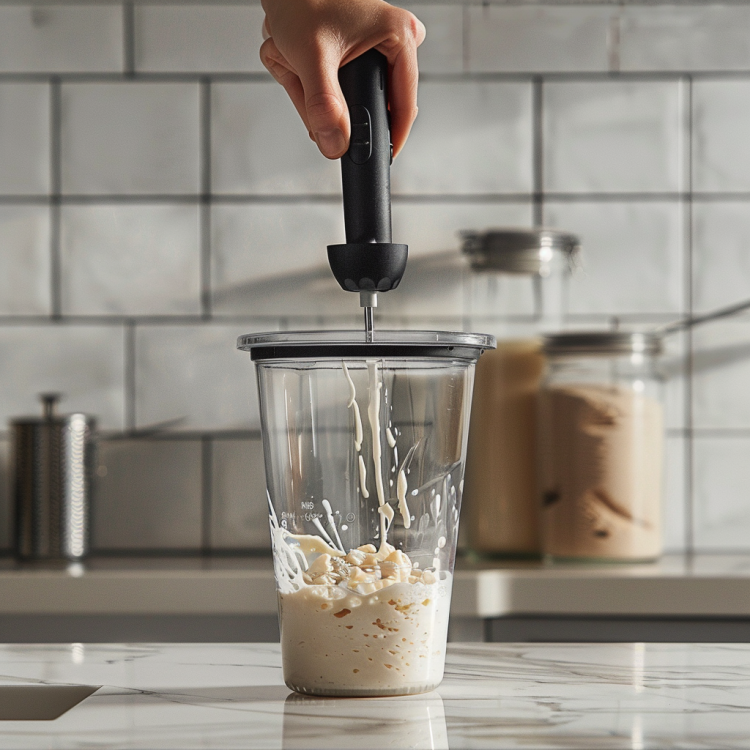
To use an immersion blender without splashing, make sure the blender head is completely submerged in the liquid or food before turning it on. Start blending at the lowest speed, and as the food begins to break down, you can gradually increase the speed if necessary. Use a tall, narrow container to prevent the liquid from spilling out. Keep the blender head slightly tilted at an angle, and move it slowly and steadily around the container. This method will help you achieve smooth blending without splattering.
When you use an immersion blender, it’s important to be mindful of its mechanics. Splashes occur when the blades spin at high speeds without being fully immersed in the mixture. This is particularly common when blending thin liquids like soups or sauces. For B2B buyers, such as chefs or kitchen equipment suppliers, the ease of use and precision of control are vital features to avoid mess and improve operational efficiency. Investing in an immersion blender that offers variable speed settings and an ergonomically designed handle makes this process smoother.

Using an immersion blender properly requires you to maintain control over the tool. By holding it steady and avoiding rapid movements, you can blend any liquid or soft food without making a mess. Additionally, don’t lift the blender out of the liquid while it’s still running, as this will send liquid flying.
How to Use an Immersion Blender Without Splattering?
To prevent splattering when using an immersion blender, keep these tips in mind:
- Submerge the blender head: Always ensure the blender head is submerged in the food or liquid before switching it on. If you start blending above the surface, the blades will push air and liquid outwards, causing a splatter.
- Use a deep bowl or container: Choose a deep container that gives you enough room to work without the liquid splashing over the edges.
- Start on low speed: High-speed blending right from the start generates turbulence that leads to splattering. Begin with the lowest speed setting and gradually increase if needed.
- Move the blender slowly: Rapid movements can cause the liquid to shoot out. Keep the immersion blender steady and move it slowly around the container.
Blending delicate liquids like soups or sauces at home or in a professional kitchen requires patience and proper technique. B2B buyers, especially those in food service industries, seek immersion blenders that offer splatter control as a core feature. Whether you’re prepping food for customers or testing a new recipe, avoiding a mess saves time and ensures a better final product.
What Is the Correct Way to Use an Immersion Blender?
The correct way to use an immersion blender involves following these essential steps:
- Prepare the right container: Use a deep, narrow container that will allow you to blend efficiently without worrying about the food spilling out.
- Submerge the blender: Ensure the blender head is fully immersed in the mixture before you turn it on. This prevents the liquid from splashing as the blades begin spinning.
- Start at a low speed: Begin blending at the lowest speed setting to avoid any sudden splashes. Gradually increase the speed as the mixture becomes smoother.
- Move the blender gently: Move the immersion blender in slow, circular motions. Keep the head under the surface and avoid pulling it out of the liquid while it’s running.
- Pulse if necessary: For tougher ingredients, use the pulse feature (if available) to chop food in short bursts without constantly running the blender.
The correct usage of an immersion blender is especially important for professional kitchens and bulk food preparation. Chefs and B2B buyers look for appliances that provide efficient, clean blending, while also offering durability and user-friendliness. An immersion blender that’s easy to control helps avoid common issues like splattering or inconsistent blending.
Does an Immersion Blender Splash?
An immersion blender can splash if it’s not used correctly. If the blades are exposed to air while blending or if you start at a high speed, the movement will push liquid outwards, leading to splashes. To prevent this, you need to keep the blender head submerged at all times, use a deep container, and avoid lifting it out while the blender is still running.
The design of modern immersion blenders often includes anti-splash guards to minimize splashing, which is a big benefit for B2B buyers in food service or manufacturing. Appliances with built-in splash guards and adjustable speed settings are preferred for commercial kitchens where minimizing mess is critical. Buyers in the hospitality industry, for example, look for immersion blenders that promise a clean and efficient workflow.

How Do You Use a Blender Without Spilling It?
To use a blender without spilling, follow these steps:
- Select the appropriate container: Use a deep, narrow container to contain the liquid and prevent it from spilling out during blending.
- Submerge the blender head fully: Always ensure the blender head is submerged in the liquid before you turn it on. This will keep the liquid from spilling or splashing out of the container.
- Start slowly: Set the blender to the lowest speed before turning it on. Once the liquid or food starts to blend smoothly, you can increase the speed gradually if necessary.
- Move the blender steadily: Move the immersion blender slowly around the container, avoiding any quick or jerky movements. If you need to move it, do so gently, and keep it below the surface at all times.
Spilling or splashing often happens when the blender head isn’t fully immersed in the food, or if you’re using a container that’s too shallow. For B2B buyers, ensuring that the immersion blender offers spill control features is a top priority, especially for commercial uses where efficiency and cleanliness are key factors.

Conclusion
In conclusion, using an immersion blender properly can prevent splashing, splattering, and spilling. By following the right techniques—such as starting at a low speed, keeping the blender head submerged, and using the right container—you can achieve clean, smooth blending every time. For B2B buyers, features like anti-splash design, durability, and user-friendly operation make immersion blenders essential tools for any kitchen.



